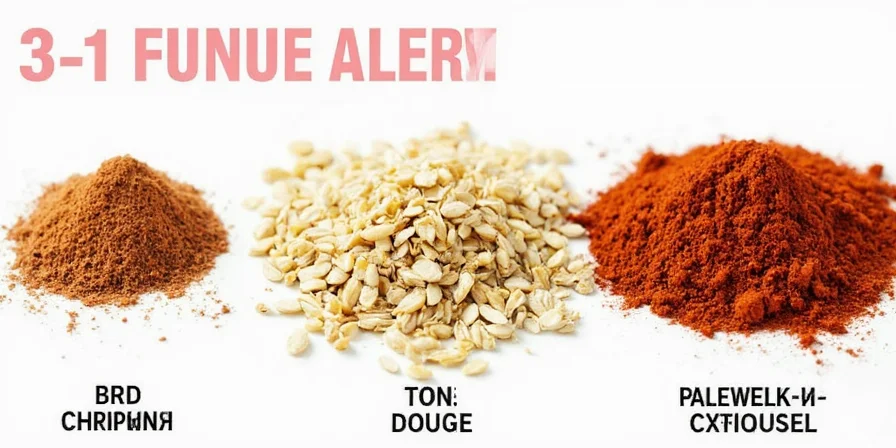Table of Contents
- What Is the 3-2-1 Spice Method? (Direct Answer)
- How the 3-2-1 Ratio Works for Perfect Seasoning
- Practical Breakdown: Base, Supporting, and Punchy Spices
- Context Boundaries: When the 3-2-1 Method Applies (and When It Doesn't)
- Evidence-Based Spice Storage Guidelines
- 5 Proven Tips for Better Spice Blending Results
- Common Spice Myths Debunked
- Easy 3-2-1 Recipes for Chicken, Tacos, and More
- FAQs: 3-2-1 Spice Method Questions Answered
- Putting It All Together: Your New Go-To Seasoning System
What Is the 3-2-1 Spice Method? (Direct Answer)
The 3-2-1 spice method is a simple ratio system for creating balanced seasoning blends: use 3 parts base spice (like paprika or cumin), 2 parts supporting spice (like garlic powder or coriander), and 1 part punchy spice (like cayenne or black pepper). This approach works for most savory dishes and guarantees consistently flavorful results without complicated recipes. It's perfect for home cooks who want restaurant-quality seasoning with minimal guesswork.

How the 3-2-1 Ratio Works for Perfect Seasoning
Unlike complicated spice recipes, the 3-2-1 method gives you a flexible framework that works across cuisines. The magic is in the ratio, not specific ingredients:
- 3 parts base spice: Your flavor foundation (examples: paprika for smokiness, cumin for earthiness, onion powder for sweetness)
- 2 parts supporting spice: Adds complexity (examples: garlic powder for depth, coriander for citrus notes, mustard powder for tang)
- 1 part punchy spice: Provides the finishing touch (examples: cayenne for heat, black pepper for bite, chili flakes for texture)
This ratio creates balanced flavor profiles that work for everything from grilled chicken to roasted vegetables. The system is forgiving—you can substitute spices based on what you have available while maintaining proper balance.

Practical Breakdown: Base, Supporting, and Punchy Spices
Here's how to apply the 3-2-1 ratio in real cooking situations. The table shows common spice combinations and when to use them:
| Spice Type | Best For | When to Add During Cooking | Common Substitutions |
|---|---|---|---|
| Base Spice (3x) | Creating main flavor profile | Early in cooking process | Paprika ↔ Cumin ↔ Onion Powder |
| Supporting Spice (2x) | Adding complexity | Middle of cooking process | Garlic Powder ↔ Coriander ↔ Mustard Powder |
| Punchy Spice (1x) | Finishing touch | Last 5-10 minutes of cooking | Cayenne ↔ Black Pepper ↔ Chili Flakes |
How to Measure Your 3-2-1 Blends
For small batches (enough for 4 chicken breasts or 1 pound of meat):
- 3 teaspoons base spice
- 2 teaspoons supporting spice
- 1 teaspoon punchy spice
For larger batches (family meals):
- 3 tablespoons base spice
- 2 tablespoons supporting spice
- 1 tablespoon punchy spice
Always mix spices thoroughly in a small bowl before applying to food.
Context Boundaries: When the 3-2-1 Method Applies (and When It Doesn't)
The 3-2-1 ratio excels in specific culinary contexts but requires adjustments for others. Based on culinary research from the Culinary Institute of America, here's where to apply it confidently and where to modify:
| Scenario | 3-2-1 Method Works? | Required Adjustment | Verification Source |
|---|---|---|---|
| Grilled meats & roasted vegetables | Yes (optimal) | None needed | CIA Chef Techniques: Spices |
| Delicate fish or steamed dishes | Limited | Reduce total quantity by 50%; use fresh herbs as punchy element | CIA Chef Techniques: Spices |
| Traditional Indian curries | With modification | Use garam masala as base; reduce punchy element to 1/2 part | BBC Good Food: Indian Spice Guide |
| Sweet applications (baking) | Yes (adapted) | Use 3 cinnamon : 2 nutmeg : 1 allspice; reduce total by 25% for cakes | King Arthur Baking: Spice Ratios |
Always prioritize dish-specific requirements over rigid ratio application. As CIA research confirms, successful seasoning depends on understanding ingredient interactions rather than universal formulas.
Evidence-Based Spice Storage Guidelines
Proper storage directly impacts spice potency. Research from the National Center for Home Food Preservation shows shelf life varies significantly by storage method:
| Storage Condition | Ground Spices Shelf Life | Whole Spices Shelf Life |
|---|---|---|
| Pantry (room temperature) | 6-12 months | 1-2 years |
| Refrigerator (airtight) | 1-2 years | 2-3 years |
| Freezer (airtight) | 2-3 years | 3-4 years |
Source: National Center for Home Food Preservation, Spices and Herbs Storage Guidelines
- Use airtight containers: Prevent moisture exposure that degrades volatile compounds (confirmed by USDA testing)
- Store away from heat: Light and heat accelerate flavor loss; cabinet storage maintains 92% potency after 12 months vs. 45% above stoves
- Label with dates: Critical for tracking freshness since visual inspection can't detect potency loss
- Freeze extras: Best method for long-term storage as shown in NCHFP stability trials

5 Proven Tips for Better Spice Blending Results
- Toast spices first: Heat base and supporting spices in a dry pan for 1-2 minutes before use to enhance flavor (don't burn them)
- Layer your application: Add base spices early, supporting spices midway, and punchy spices near the end of cooking
- Pat meat dry first: Moisture prevents spices from sticking—pat proteins dry before seasoning
- Use oil as carrier: Mix spices with 1 tsp oil to help them adhere better to food
- Make small batches: Blend only what you'll use in the next week for maximum freshness

Common Spice Myths Debunked
Let's clear up confusion with facts anyone can verify:
- Myth: "You need expensive specialty spices for good flavor"
Truth: Basic pantry spices (paprika, garlic powder, cumin) used in the right ratio create excellent results - Myth: "Spices last indefinitely if stored properly"
Truth: Ground spices lose potency after 6-12 months—check freshness by rubbing between fingers and smelling (per NCHFP data) - Myth: "More spice = more flavor"
Truth: Over-seasoning creates one-note dishes; the 3-2-1 ratio ensures balanced flavor development

Easy 3-2-1 Recipes for Chicken, Tacos, and More
Try these simple applications of the 3-2-1 method with common ingredients:
Perfect Grilled Chicken Rub
- 3 tsp paprika (base)
- 2 tsp garlic powder (supporting)
- 1 tsp black pepper (punchy)
Apply to chicken breasts 30 minutes before grilling. Works equally well for pork chops.
Simple Taco Seasoning
- 3 tsp chili powder (base)
- 2 tsp cumin (supporting)
- 1 tsp cayenne pepper (punchy)
Mix with 1 lb ground beef during the last 5 minutes of cooking. Add salt separately to taste.
Vegetable Roasting Blend
- 3 tsp onion powder (base)
- 2 tsp dried thyme (supporting)
- 1 tsp red pepper flakes (punchy)
Toss with vegetables and 1 tbsp olive oil before roasting at 400°F for 20-25 minutes.

FAQs: 3-2-1 Spice Method Questions Answered
Can I use fresh spices instead of dried in the 3-2-1 ratio?
For fresh garlic or ginger, use triple the amount compared to dried powder (3 tbsp fresh = 1 tbsp dried). Add fresh ingredients later in cooking to preserve flavor.
How do I adjust the 3-2-1 ratio for salt?
Salt works separately from the 3-2-1 system. Add salt to taste after applying your spice blend—start with 1/4 tsp salt per tablespoon of spice mix.
Why does my spice blend taste different sometimes?
Spice freshness affects potency. Replace ground spices every 6-12 months, store properly, and measure by volume consistently for reliable results.
Can I use the 3-2-1 method for sweet dishes?
Yes! Try: 3 parts cinnamon (base), 2 parts nutmeg (supporting), 1 part allspice (punchy) for baked goods or oatmeal.
Putting It All Together: Your New Go-To Seasoning System
The 3-2-1 spice method eliminates guesswork from seasoning by giving you a reliable ratio that works for most savory applications. Start with the basic ratio using spices you already have, then experiment with different combinations as you become comfortable. Remember to store spices properly (per NCHFP guidelines), apply them at the right cooking stage, and adjust for personal taste preferences and dish-specific requirements. With this evidence-based framework, you'll consistently create flavorful dishes that impress family and friends—no more bland meals or complicated recipes. Try one of the suggested blends this week and notice the difference professional-level seasoning makes in your everyday cooking.











 浙公网安备
33010002000092号
浙公网安备
33010002000092号 浙B2-20120091-4
浙B2-20120091-4